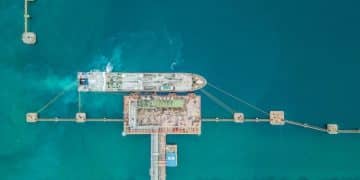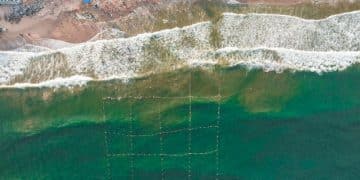US Fishing Regulations: Impact on Marine Ecosystems Explored

Navigating the intricate landscape of US fishing regulations reveals a complex interplay of federal and state laws, primarily governed by statutes like the Magnuson-Stevens Act, aiming to balance economic needs with the imperative of marine ecosystem health and resource sustainability for future generations.
Understanding what are the current regulations regarding fishing practices and their impact on marine ecosystems in the US? requires delving into a multifaceted framework designed to manage and conserve marine resources. This complex web of legislation, policy, and scientific assessment seeks to balance the economic vitalities of fishing with the ecological imperative of protecting our oceans. As a journalist, I’ve observed firsthand how these regulations evolve, grappling with the dynamic challenges posed by climate change, technological advancements, and shifting societal priorities. The story of marine conservation in the US is one of continuous adaptation, driven by a commitment to safeguard biodiversity and ensure sustainable fisheries for generations to come. It’s a narrative that blends science, economics, and environmental stewardship, often sparking debate but always striving for a healthier ocean.
The foundational pillars of US fisheries management
The cornerstone of fisheries management in the United States is undoubtedly the Magnuson-Stevens Fishery Conservation and Management Act (MSA). Enacted in 1976 and reauthorized multiple times, including significant amendments in 1996 and 2007, the MSA established a comprehensive framework for managing marine fisheries in federal waters. This landmark legislation moved the US from a “laissez-faire” approach to a more proactive, science-based management system. Its primary goal is to prevent overfishing, rebuild overfished stocks, ensure conservation, and realize the full potential of the nation’s fishery resources.
Under the MSA, eight regional fishery management councils are responsible for developing fishery management plans (FMPs) for species under their jurisdiction. These councils, composed of federal and state officials, as well as representatives from the fishing industry, academia, and environmental groups, embody a collaborative approach to governance. Their work is a constant balancing act, aiming to satisfy the diverse needs of stakeholders while adhering to the conservation mandates of the Act. This decentralized system allows for tailored management strategies that consider regional ecological differences and fishing traditions.
The role of fishery management councils
The regional councils are vital in translating the broad objectives of the MSA into actionable plans. They conduct extensive research, gather public input, and debate various management options before submitting their FMPs to the Secretary of Commerce for approval. These plans outline specific regulations, such as:
- Catch limits (total allowable catch, or TACs)
- Permitting requirements and gear restrictions
- Seasonal or area closures to protect spawning grounds or vulnerable habitats
- Measures to reduce bycatch, the incidental capture of non-target species
The process is often complex and contentious, involving scientific uncertainty, economic pressures, and social considerations. However, it’s also designed to be adaptive, allowing for adjustments as new data emerges or environmental conditions change.
Another crucial element of US fisheries management involves state-level regulations. While the MSA governs fishing in federal waters (generally from 3 to 200 nautical miles offshore), states maintain jurisdiction over their “inland” and “nearshore” waters. This division of authority necessitates close coordination between federal and state agencies, often facilitated through interstate commissions like the Atlantic States Marine Fisheries Commission and the Pacific States Marine Fisheries Commission. These commissions work to harmonize regulations across state lines, particularly for migratory species, to ensure a cohesive and effective national management strategy.
Impact of fishing practices on marine ecosystems: a closer look
The impact of fishing practices on marine ecosystems is multifaceted, ranging from direct effects like depletion of target species to broader, indirect consequences on habitats and food webs. Understanding these impacts is critical for developing effective regulations and fostering sustainable fishing. Overfishing, for instance, not only reduces fish populations but can also disrupt the delicate balance of predator-prey relationships, leading to trophic cascades that reverberate throughout the ecosystem.
Bycatch, the unintentional capture of non-target species, poses another significant challenge. This can include juvenile fish, marine mammals, sea turtles, and seabirds, many of which are endangered or protected. The discard of bycatch, often dead or injured, represents a substantial waste of marine life and can have severe ecological consequences. Regulatory efforts, such as mandating specific gear modifications or time/area closures, aim to minimize bycatch, but it remains an ongoing concern in many fisheries.
Habitat destruction and alteration
Certain fishing gear types can cause considerable damage to marine habitats. Bottom trawls, for example, drag heavy nets across the seafloor, potentially destroying sensitive benthic ecosystems like coral reefs, sponge gardens, and seagrass beds. These habitats provide critical nursery grounds, feeding areas, and shelter for a vast array of marine species. The recovery of such damaged habitats can take decades, if not centuries.
The loss of complex habitats reduces biodiversity and diminishes the ocean’s capacity to support healthy fish populations. Regulations such as gear restrictions, marine protected areas (MPAs), and habitat conservation zones are implemented to mitigate these impacts, but balancing conservation needs with the economic realities of fishing communities is a continuous challenge. Moreover, the cumulative effects of various human activities, including fishing, coastal development, and pollution, add layers of complexity to marine ecosystem management.
Beyond direct impacts, fishing can also alter the genetic diversity of fish stocks, leading to smaller, less resilient populations over time if management practices preferentially target larger, faster-growing individuals. This “fisheries-induced evolution” is a subtle but potentially profound long-term threat to the health and adaptability of marine species. Consequently, modern fisheries management increasingly considers these evolutionary impacts, striving for harvest strategies that maintain genetic diversity and population resilience.
Regulatory mechanisms for sustainable fisheries

To promote sustainable fisheries, US regulations employ a variety of mechanisms beyond simple catch limits. These tools are designed to address the diverse challenges of marine resource management, from ensuring the health of target species to protecting the broader marine environment. One of the most effective strategies is the implementation of annual catch limits (ACLs), coupled with accountability measures (AMs). These ensure that if a stock’s catch limit is exceeded, appropriate actions are taken to prevent future overages and rebuild the stock. This proactive approach has been instrumental in rebuilding numerous fish stocks that were once on the brink of collapse.
Gear restrictions play a crucial role in mitigating the environmental impact of fishing. These can range from requirements for specific mesh sizes in nets to allow smaller, juvenile fish to escape, to mandating the use of bycatch reduction devices (BRDs) that help non-target species avoid capture. For example, Turtle Excluder Devices (TEDs) in shrimp trawls allow sea turtles to escape, significantly reducing their mortality rates. Similarly, modifications to longline fishing gear can prevent seabirds from getting hooked.
Spatial and temporal closures
Another powerful regulatory tool involves establishing spatial and temporal closures. These are designated areas or periods where fishing is prohibited or restricted. Such closures serve multiple purposes:
- Protecting spawning aggregations, allowing fish to reproduce undisturbed.
- Safeguarding critical nursery habitats for juvenile fish and other marine life.
- Providing refuge for overfished stocks to recover.
- Minimizing interactions with vulnerable species, such as marine mammals during migration or feeding.
Marine Protected Areas (MPAs) are a specific type of spatial closure that can offer permanent protection to certain habitats and species, contributing to broader ecosystem health and resilience. While sometimes controversial, closures are vital for conservation, offering a respite for marine ecosystems to heal and flourish, ultimately benefiting long-term fishery productivity.
Individual Fishing Quotas (IFQs) or catch shares represent a market-based approach to fisheries management. Under an IFQ system, a total allowable catch is determined for a fishery, and individual fishermen or cooperatives are allocated a share of that quota. This system aims to create economic incentives for conservation, as fishermen have a vested interest in the long-term health of the stock. By providing greater stability and security, IFQs can reduce the race to fish, improve safety, and foster more thoughtful, sustainable fishing practices.
Challenges and complexities in regulatory enforcement
Enforcement of fishing regulations in the vast and dynamic marine environment is a significant undertaking, fraught with challenges. The sheer scale of federal waters, combined with the often-elusive nature of fishing activities, requires substantial resources and sophisticated strategies. Agencies like the National Oceanic and Atmospheric Administration (NOAA) Fisheries and the US Coast Guard work collaboratively to monitor compliance, but their efforts are constantly tested by the ingenuity of those seeking to circumvent rules and the inherent difficulties of at-sea surveillance.
One primary challenge lies in data collection and monitoring. Accurate, timely data on catch, effort, and compliance is essential for effective management. This involves observer programs, vessel monitoring systems (VMS), and port-side inspections, each with its own logistical hurdles and costs. The vastness of the ocean makes comprehensive real-time monitoring difficult, often leading to reliance on self-reporting, which can be prone to inaccuracies. Furthermore, different state and federal jurisdictions can create complex enforcement boundaries, requiring robust interagency cooperation.
Illegal, unreported, and unregulated (IUU) fishing
Illegal, Unreported, and Unregulated (IUU) fishing is a global problem that also impacts US waters and global fish stocks that migrate through them. IUU fishing undermines conservation efforts, distorts markets, and puts legitimate fishermen at a disadvantage. While the US has strong domestic enforcement, efforts extend to combating IUU fishing internationally through diplomatic initiatives, port state measures, and traceability programs. Tools to combat IUU fishing include:
- Increased surveillance, including satellite monitoring
- Improved port State measures to prevent illegally caught fish from landing
- International cooperation and information sharing
- Traceability systems to track seafood from vessel to plate
Despite these measures, the economic incentives for illegal fishing remain high, presenting an ongoing challenge for regulatory bodies worldwide.
Technological advancements, while offering new tools for monitoring and enforcement, also present new challenges. For instance, more sophisticated fishing gear can increase fishing efficiency, potentially leading to rapid stock depletion if not adequately regulated. The rapid pace of technological change often outstrips the ability of regulations to adapt, creating a constant need for review and revision. Moreover, securing adequate funding for enforcement agencies and scientific research is a continuous political battle, directly impacting the effectiveness of regulatory programs.
Ecosystem-based fisheries management (EBFM): a holistic approach
Recognizing the intricate connections within marine environments, there’s a growing shift towards Ecosystem-Based Fisheries Management (EBFM). Unlike traditional approaches that often focus on single species in isolation, EBFM considers the broader ecosystem, including habitats, predator-prey dynamics, and the impacts of environmental change. This holistic perspective aims to manage human activities, including fishing, in a way that maintains ecosystem health and resilience, ensuring the long-term sustainability of marine resources.
EBFM requires a deeper understanding of ecosystem functioning, often necessitating more comprehensive data collection and complex modeling. It integrates various scientific disciplines, including oceanography, marine biology, and socio-economics, to inform management decisions. The goal is not just to prevent overfishing of one stock but to ensure the entire food web and habitat structure remain intact and functional. This approach is more precautionary, acknowledging uncertainties and striving to minimize risk to the ecosystem as a whole.
Implementing EBFM in practice
Translating the principles of EBFM into practical management measures is a complex endeavor. It involves:
- Identifying key ecosystem components and their interactions
- Assessing cumulative impacts of multiple human activities
- Developing management strategies that consider ecosystem limits, not just single-species quotas
- Fostering interagency and inter-jurisdictional collaboration
While still evolving, components of EBFM are increasingly being integrated into US fisheries management. For example, some regional fishery management councils are developing ecosystem plans that outline broad conservation objectives and identify research priorities to support EBFM. This may involve setting catch limits that account for the needs of predator or prey species, protecting critical habitats, or managing fisheries in the context of climate change impacts.

The transition to EBFM is not without its challenges. It requires significant investment in scientific research, robust data infrastructure, and advanced analytical tools. Furthermore, it often demands greater flexibility and adaptive management, as the interplay of complex ecological factors can be unpredictable. Despite these hurdles, EBFM represents a promising path forward for ensuring the resilience and productivity of marine ecosystems in the face of increasing human pressures and environmental change. It’s a recognition that healthy fisheries depend on healthy oceans, and that comprehensive stewardship is essential for both.
Future directions and emerging issues
As marine ecosystems face mounting pressures from climate change, ocean acidification, and increasing human population, the regulatory landscape for fishing practices in the US must continuously evolve. One of the most pressing emerging issues is the impact of climate change on fish stocks. Changing ocean temperatures, currents, and ocean chemistry are altering marine species’ distribution, abundance, and phenology. This necessitates adaptive management strategies that can respond to these shifts, for example, by adjusting catch limits or re-evaluating seasonal closures.
The increasing focus on traceability and combating illegal, unreported, and unregulated (IUU) fishing also represents a significant future direction. Consumers, retailers, and governments are demanding greater transparency in the seafood supply chain to ensure that products are legally and sustainably sourced. Programs like the Seafood Import Monitoring Program (SIMP) are designed to combat IUU fishing and seafood fraud by requiring more comprehensive data for imported seafood, fostering a more responsible global market.
Technological advancements and blue economy
Technological advancements are simultaneously creating new opportunities and challenges for fisheries management. Innovations in remote sensing, data analytics, and artificial intelligence offer promising tools for monitoring fish stocks, tracking vessels, and assessing ecosystem health. However, these technologies also raise questions regarding privacy, data security, and equitable access. Simultaneously, the concept of a “blue economy” – sustainable use of ocean resources for economic growth – is gaining traction, promoting sectors like sustainable aquaculture, marine renewable energy, and eco-tourism, all of which require integration into existing regulatory frameworks to avoid conflicts and ensure holistic ocean health.
The development of offshore aquaculture is another rapidly expanding area that will require careful regulatory oversight. While aquaculture can help meet global seafood demand and reduce pressure on wild stocks, it also poses potential environmental risks such as habitat modification, waste discharge, and disease transmission to wild populations. Regulations are being developed to minimize these impacts while fostering the growth of a sustainable aquaculture industry in US waters. This expansion demands a thoughtful, science-based approach to ensure it complements, rather than compromises, wild fisheries and marine ecosystems. The future of US fisheries regulations will be shaped by these complex interactions, demanding continuous adaptation, robust scientific research, and collaborative governance.
Success stories and remaining challenges
Despite the immense challenges, US fisheries management boasts significant success stories, demonstrating the effectiveness of the Magnuson-Stevens Act and the dedication of scientists, managers, and the fishing industry. Many previously overfished stocks, such as Atlantic sea scallops, Georges Bank haddock, and Pacific groundfish, have been successfully rebuilt, leading to increased catches and economic benefits. These successes often stem from a combination of strict catch limits, habitat protection measures, and improved enforcement.
However, significant challenges persist. Some fish stocks remain overfished or are experiencing rebuilding delays due to environmental factors, climate change impacts, or difficulties in assessing actual stock sizes. The complexity of managing highly migratory species that cross regional and international boundaries also presents ongoing hurdles, requiring extensive cooperation with other nations. Furthermore, balancing the economic needs of small-scale fishing communities with the imperative for conservation remains a delicate and ongoing societal debate.
Adapting to a changing ocean
One of the foremost remaining challenges is adapting to an ocean fundamentally altered by climate change. As species shift their ranges, marine heatwaves become more frequent, and ocean acidification intensifies, traditional management boundaries and assumptions are being tested. This necessitates a proactive and adaptive approach, including:
- Developing climate-ready fisheries management plans.
- Prioritizing research on climate impacts and ecosystem resilience.
- Fostering international cooperation on shared stocks affected by climate-induced migration.
- Investing in monitoring and forecasting tools to predict ecosystem shifts.
The transition to a truly ecosystem-based management approach is also a continuous journey, moving beyond single-species considerations to encompass the health of the entire marine ecosystem. This requires integrating data from various sectors, addressing cumulative impacts, and strengthening collaborations across different government agencies and stakeholder groups. Ultimately, the ongoing success of US fisheries management will hinge on its ability to evolve and innovate in response to these complex environmental and socio-economic dynamics, securing healthy oceans and sustainable seafood for future generations.
| Key Aspect | Brief Description |
|---|---|
| 🐠 Magnuson-Stevens Act | The primary federal law guiding US fisheries management since 1976, focusing on preventing overfishing and rebuilding stocks. |
| 生態 Ecosystem Impact | Fishing affects marine life through overfishing, bycatch, and habitat destruction, impacting biodiversity and food webs. |
| ⚖️ Regulatory Tools | Includes catch limits, gear restrictions, spatial/temporal closures, and IFQs to ensure sustainable practices. |
| 🌐 Future Challenges | Climate change, IUU fishing, and promoting a ‘blue economy’ are key areas for future regulatory adaptation. |
Frequently Asked Questions About US Fishing Regulations
▼
The Magnuson-Stevens Fishery Conservation and Management Act (MSA) is the primary law governing marine fisheries in US federal waters. It mandates science-based management to prevent overfishing, rebuild depleted stocks, and ensure the long-term sustainability of marine resources. The MSA’s framework has led to significant successes in stock rebuilding and serves as a global model for fisheries management.
▼
To reduce bycatch, regulations include requirements for specific fishing gear modifications, such as Turtle Excluder Devices (TEDs) or Bycatch Reduction Devices (BRDs) in nets. Additionally, time and area closures are implemented to avoid fishing in areas where vulnerable non-target species are known to aggregate, aiming to minimize the incidental capture of unintended marine life.
▼
US fishing zones are divided between state waters (generally from shore to 3 nautical miles) and federal waters (from 3 to 200 nautical miles, known as the Exclusive Economic Zone). State agencies manage their respective waters, while federal waters are regulated by NOAA Fisheries under the MSA, with management plans developed by regional fishery management councils to address local needs.
▼
Climate change is altering ocean temperatures and currents, shifting fish distributions, and increasing ocean acidification. Regulations are beginning to adapt by integrating climate data into stock assessments, adjusting catch limits to account for new environmental realities, and exploring adaptive management strategies to build resilience in marine ecosystems. This includes a growing focus on ecosystem-based management.
▼
EBFM is a holistic approach that manages fisheries by considering the entire ecosystem, including habitats, predator-prey dynamics, and environmental factors, rather than focusing on single species. It aims to maintain overall ecosystem health and resilience. This approach is vital because it acknowledges the interconnectedness of marine life, ensuring long-term sustainability by protecting the broader environment.
Conclusion
The intricate tapestry of US fishing regulations, primarily woven by the Magnuson-Stevens Act, represents a dynamic and continuous effort to balance the economic vitalities of fishing with the profound ecological imperative of protecting marine ecosystems. From regional council management to the pursuit of ecosystem-based approaches, the journey towards sustainable fisheries is marked by both commendable successes in stock rebuilding and persistent challenges, particularly those posed by climate change and illegal activities. As a journalist, I’ve seen that the dialogue around these regulations is complex and often charged, but it universally strives for a healthier, more resilient ocean. The future of America’s marine life and the fishing communities that depend on it rests on continued scientific innovation, adaptive governance, and a shared commitment to stewardship, ensuring that our oceans can thrive for generations to come.





